Imagine you’re excitedly telling your friends about this amazing toy store you visited. They trust your recommendation, rush to the store, and end up buying some fantastic toys. The store owner is so grateful for your help that they reward you with a small gift or some money as a thank-you gesture.
Well, affiliate marketing operates on a similar principle.
In affiliate marketing, individual publisher or content creator, known as affiliates, share information about products from a company’s website.
When someone makes a purchase based on the affiliate’s recommendation, the company gives a portion of the sale money to the affiliate. It’s like getting a reward for assisting a company in selling their products.
Whether you’re thinking about venturing into affiliate marketing as an affiliate marketer or considering using this model to promote your business’s products or services, it’s essential to weigh the pros and cons of affiliate marketing. This will give you a thorough understanding of how the industry works.
Table of Contents
The Benefits of Affiliate Marketing
1. Low startup costs
Starting an affiliate marketing business doesn’t need a big investment. The main costs are about creating a website, which means buying a domain name and paying for hosting.
You might choose to spend more on things like email marketing software or setting aside money for social media ads, but these are optional.
Of course, low costs doesn’t mean. You should plan a budget of $500-$3000 for:
- Hosting
- Spy Tools
- Tracking Software
- Landing Page Builder
- Ad Budget
To make some quick bucks, publish a blog with low-competition keywords and focus on long-tail terms. Use platforms like Facebook and TikTok for free traffic.
Surprisingly, you can do affiliate marketing even without a website, though it’s not the best way.
2. A booming business
Affiliate marketing is on the rise! According to Influencer Marketing Hub’s report, global spending in affiliate marketing is expected to jump to $15.7 billion in 2024, up from $14.3 billion in 2023.
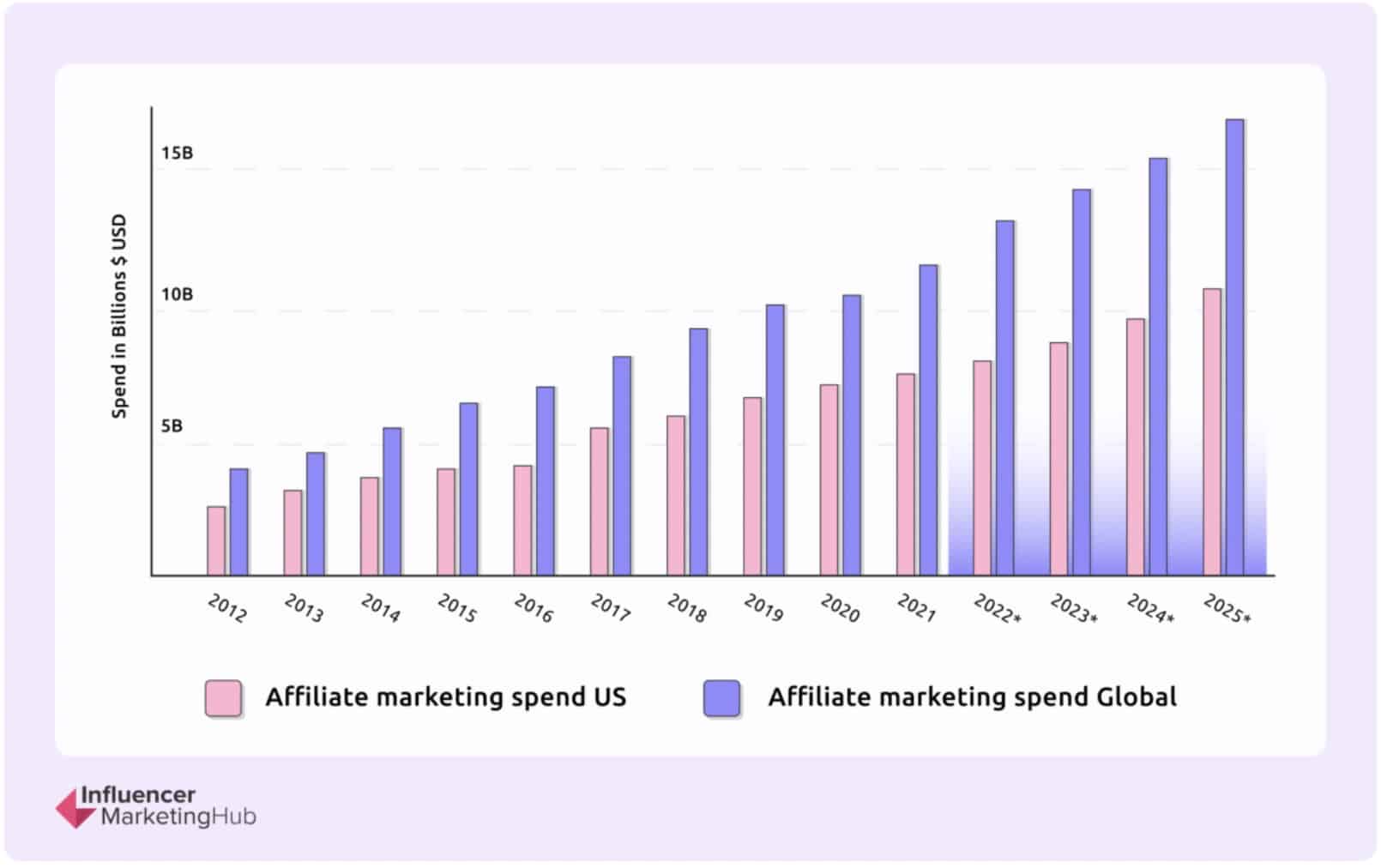
Guess what? The US leads the pack in affiliate marketing spending. From 2010 to 2017, spending in the US skyrocketed from $5.4 billion to a whopping $8.95 billion in 2022. And it’s not just the US – countries like Australia, Japan, Germany, and France have also seen growth in affiliate marketing spending.
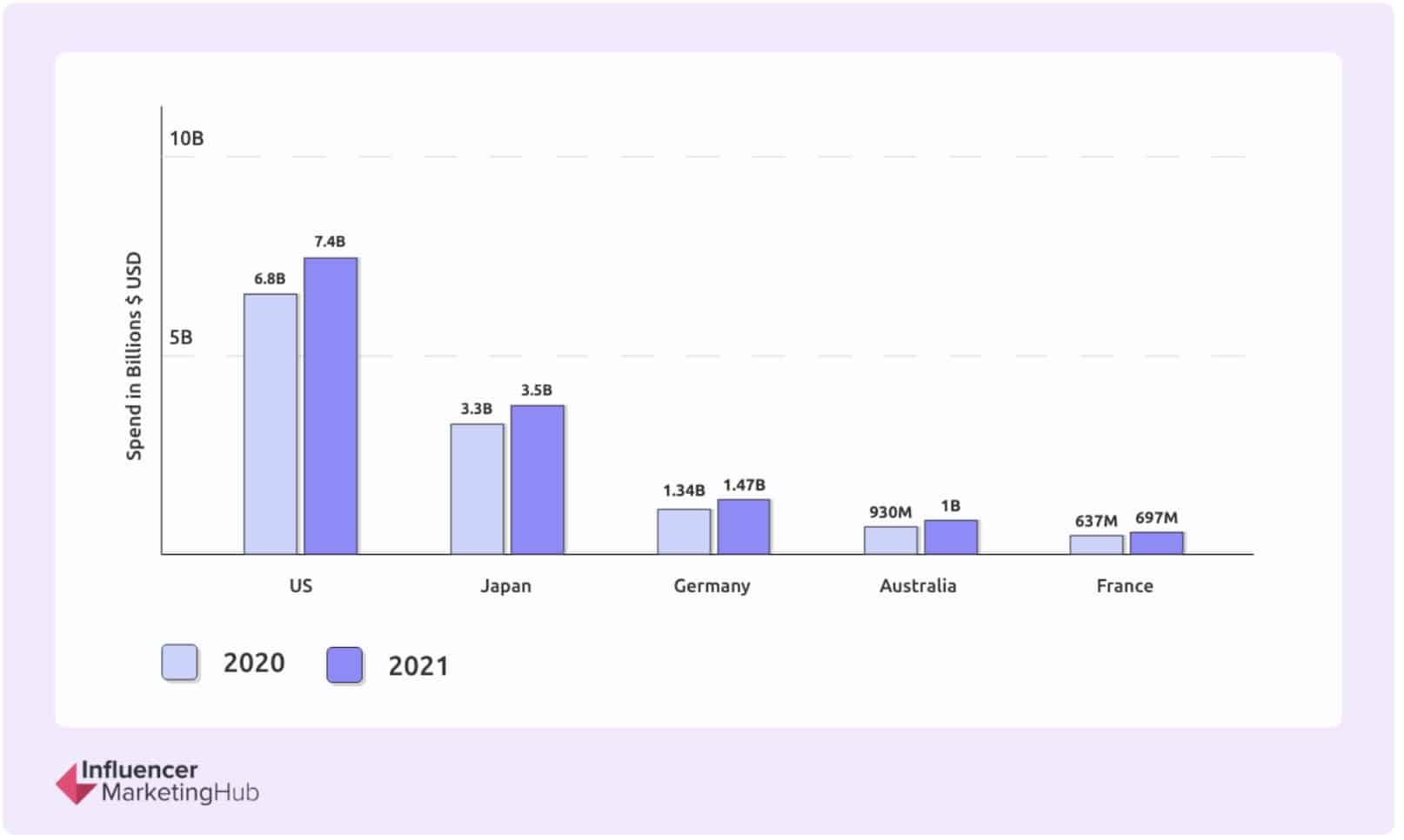
So, if you’re thinking of diving into this fast-growing niche, even as a newbie, there’s a good chance you can grab a slice of the pie!
3. Attractive commissions
Affiliate marketing has a high income potential. Companies give affiliates a cut of the sale made through their special link. For instance, some companies pay up to half (50%) of the product’s price as a commission.
Some companies even pay commissions for what people do after clicking your link. This means you can earn even more.
And there are companies that pay you for every repeat purchase, letting you make money over a long time.
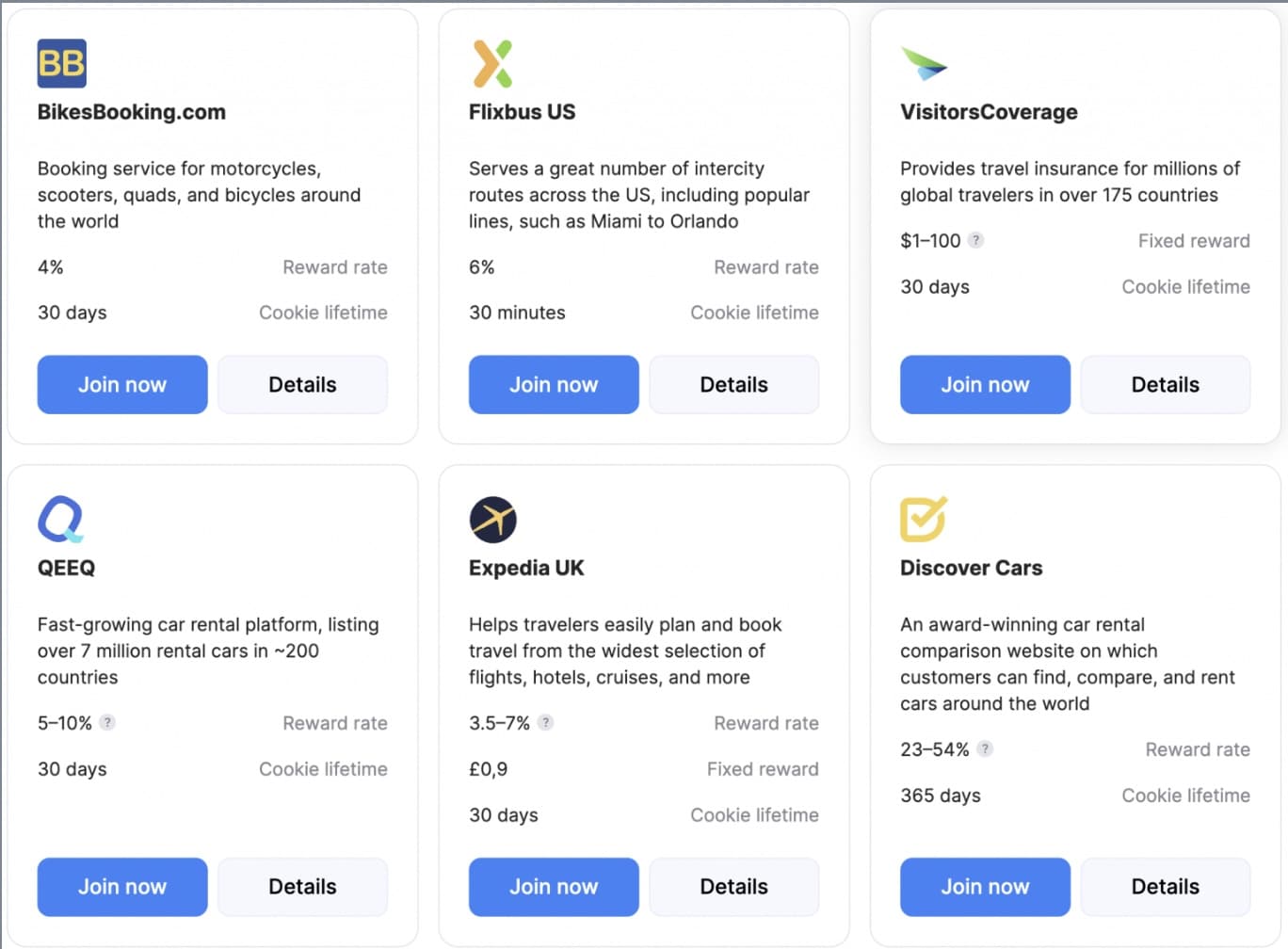
In the picture from Travelpayout, you can see different commission rates for travel companies. Travelpayout gives you 7% of what your referrals earn.
There are also high-paying programs, like Semrush, which pays $200 for every new subscription and $10 for every new lead. Bluehost’s affiliate program is also generous with commissions. They pay you $65 for every hosting purchase you refer that meets their criteria.
4. No customer service or logistics
Affiliate marketers have it easy. They don’t deal with customer service or the hassle of handling products. All they do is get people to click on the link that takes them to the product or service page. After that, the brand or company takes care of everything else.
Managing deliveries, handling complaints, and dealing with returns can be a big headache for product sellers. It’s like having a full-time job just dealing with the logistics.
But as an affiliate, you don’t have to worry about any of that. Just concentrate on promoting, and let others handle the nitty-gritty details.
5. Super scalability
Scaling an affiliate marketing business is often easier than growing a traditional business that sells its own products. Why? Because you’re not stuck with just one product or service.
You can advertise many offers and use platforms to bring more people to your links. With about 100,000 Google searches happening every second, there’s an almost endless list of keywords you can target.
You can also add more products to what you’re promoting. Check out what your competitors are up to using spy tools or a simple Google search.
As you make more money, you can expand. Get a team to create more content, invest in paid channels, start new campaigns for different products, or even launch more websites.
In affiliate marketing, you can keep growing without limits.
6. Work from anywhere
In affiliate marketing, you’re your own boss. No need for a fancy office or sticking to regular office hours. You can run your business from anywhere in the world.
All you need is a laptop and an internet connection. This means you can live a nomadic life, earning a steady income while staying wherever you please. Just pick the products or services you want to promote and create your own marketing plans.
According to Buffer’s State of Remote Work 2023, 98% of people surveyed prefer working remotely, and the same percentage would recommend it to others. Affiliate marketing is a great option if you want to work remotely. It gives you incredible flexibility and the power to build a solid income stream.
7. Marketing kit provided
As an affiliate marketer, you often get handy marketing kits. These kits pack in stuff like banners, images, links, scripts, and product info – basically, all you need to market products. They might even throw in testimonials or videos you can show your audience.
Take ClickBank, for instance. Lots of sellers there offer marketing materials just for affiliates. Finding these gems is easy. Check the seller’s marketplace listing for an affiliate tools page. Or, send them a message and ask for the marketing resources.

8. Endless choices of products to promote
Amazon’s affiliate program is well-known, but there are many other options for those starting in affiliate marketing.
Businesses and brands, such as Impact, CJ Affiliate, ShareASale, FlexOffers, and Rakuten Advertising, have affiliate programs too.
These networks cover over 30 product categories like B2B, education, electronics, fashion, finance, food, health, marketing, pet, software, and travel.
This diversity ensures there’s something for everyone, offering affiliates a wide range of choices.
The Disadvantages of Affiliate Marketing
1. You’re essentially growing someone else’s business
Unfortunately, the reality is that even the best affiliate marketers often end up making more money for others than for themselves.
Affiliate marketplace vendors are smart – they won’t pay you more than they can afford. If you’re getting a 50% commission, it’s probably because they expect to make a lot more money from the customers you bring in.
According to Ceo Dose, a YouTube content creator, affiliate marketing isn’t a quick way to get rich. The YouTube channel mentions that it usually takes 18 to 36 months to start earning a significant income from affiliate marketing. And once a customer clicks on the affiliate link, they become the merchant’s customer.
2. No say on affiliate programs
Many affiliates worry because they can’t control what happens to the products they promote. You might have a great plan to boost a product, but then the seller changes the price, stops selling it, or removes important features.
You don’t have a say in the product’s quality, availability, or delivery. If the product doesn’t meet expectations, it can hurt you as the promoter.
This lack of control is a big drawback, especially if the company you’re working with has quality issues. Wisdom Speaks, a content creator and affiliate marketer, shared in his “Revealing THE UGLY Truth About Affiliate Marketing” video how he lost money using traditional affiliate marketing. He made over $10,000 in the first 3 weeks but faced big losses when refunds started pouring in. The next month, he earned less than $1,000.
Suddenly, you have to rethink your whole marketing and business plan.
3. High competition
Promoting a product in today’s competitive market is tough. When you decide to feature a product on your website, chances are many others are doing the same.
It becomes a big challenge to get the attention of the right people in this crowded space.
Affiliate marketing is a popular way for content publishers to boost earnings. According to a 2016 study by Forrester Consulting, about 84% of online publishers use it, and 94% of them are in 2 or more affiliate programs.
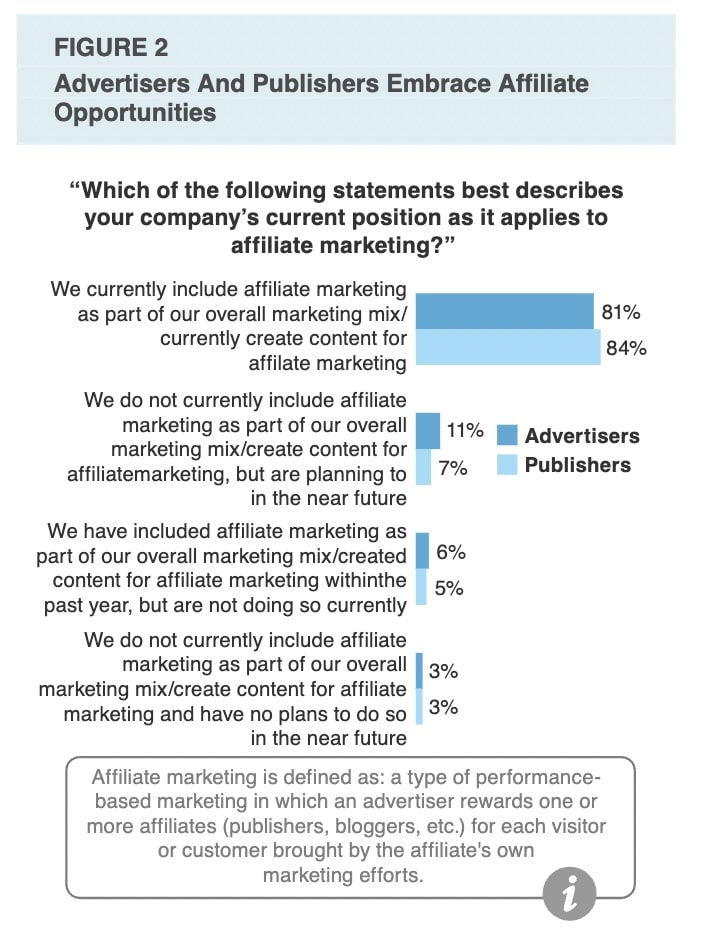
Many go further, with 39% in 3 or more programs. Some even work with up to 5 programs at once.
Since most newbies don’t need many skills or upfront capital, it’s hard for them to stand out.
To survive in this crowded space, you must create valuable content for organic traffic or be ready to pay for ads. The more popular the product, the more you’ll spend to get clicks that turn into sales.
4. Short cookie window
Most internet marketing companies pay for clicks on ads, but affiliate programs work in a different way. They follow a sales commission model, which means they pay when a purchase is made.
Unlike just clicking on ads, affiliates only earn money when someone actually buys something. This involves using a temporary browser cookie to keep track of the items that were purchased. However, merchants usually prefer shorter durations to reduce commission payouts.
For example, Amazon’s affiliate program uses a 24-hour cookie. So, if someone clicks on your link and makes a purchase within 24 hours, you get paid. But if they make a purchase after 24 hours, you won’t earn any money for it.
5. Hard to establish trust
When people find out you’re making money by promoting products on your site, it can be hard to convince them you genuinely care about their best interests.
There’s a conflict of interests. Many digital marketers tend to downplay the downsides of the products they promote.
Some even go to extremes by exaggerating the benefits, especially in the health industry. Clickbank affiliates, for instance, are known for making bold claims about weight loss supplements with high commission rates. They might even use fake before-and-after pictures.
Because of scammers, the rest of us have to work even harder to earn trust from our audiences.
6. Need a lot of patience and hard work
Getting started with affiliate marketing can be challenging. It’s not a quick success story – think more like a journey with some bumps along the way. While a few people may have hit it big early, that’s not the usual story.
As a general guide, most affiliates start seeing regular commissions after 6 to 12 months. Let’s check out some real examples:
1. Lauren Wittry from Becoming WellThy.com
- Blog Start Date: September 2016
- First Sale: Same month
- Amount: $13.50
- Affiliate Network: ShareaSale
2. Sireesha Narumanchi from CrowdWorkNews.com
- Blog Start Date: March 2021
- First Sale: June 2021
- Amount: $300
- Affiliate Network: Amazon
3. Divine Mwimba from LadiesMakeMoney.com
- Blog Start Date: November 2017
- First Sale: December 2017
- Amount: $86
- Affiliate Network: Clickbank
4. Debbie Gartner from TheFlooringGirl.com
- Blog Start Date: 2011
- First Sale: January 2016 (4.5 years later!)
- Amount: $100
- Affiliate Network: Amazon
Everyone has their own pace in making money through affiliate marketing.
Success in affiliate marketing requires time, effort, and dedication. To stand out, you’ll need different strategies when promoting various products. It’s a long-term game that demands commitment. Here’s what you should focus on:
- Build an audience
- Get your affiliate website ranked in search engines
- Grow a following on social media
- Invest in paid ads
- Find lucrative offers for products in your niche
Stay dedicated, and over time, you can earn consistent affiliate commissions.
7. Income fluctuation
Making money with affiliate marketing is like taking on opportunities and risks. It’s not a guarantee that you’ll earn a specific amount unless you have solid strategies in place. You need to put in your best effort, but still, there’s no assurance of hitting a definite income.
Your affiliate income can go up and down. If you can build a big audience, you might see a steady income on average.
Here’s an example: the famous blogger Adam Froy made $281,776 in June 2021 with 341k website traffic.

But now, he’s not sharing his income, and a quick search shows his traffic dropped to around 40k. Since web traffic is closely linked to income, we can expect his affiliate earnings to have decreased by more than 80% since his last income report.
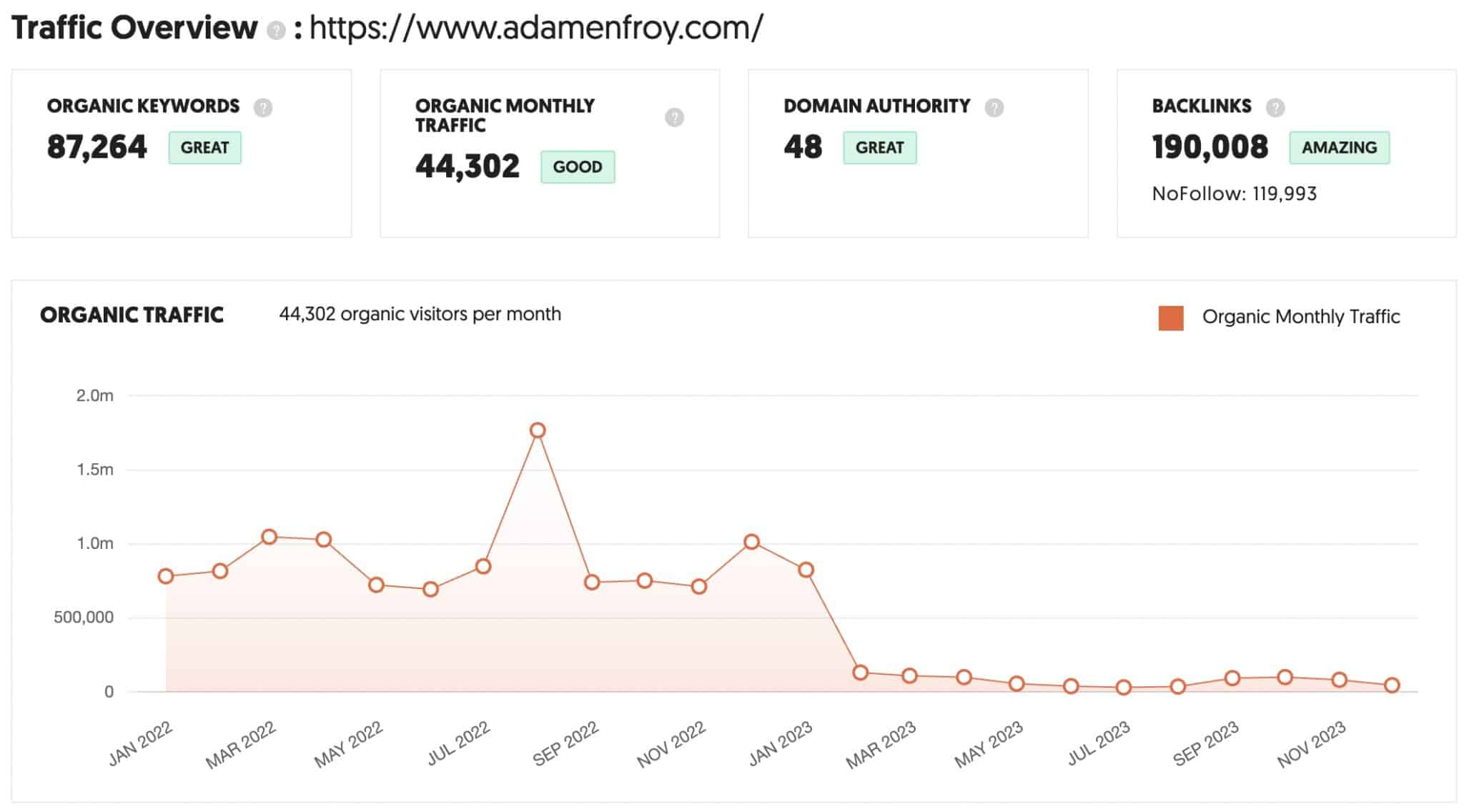
Is Affiliate Marketing Worth It?
Affiliate marketing can be profitable if you have a solid strategy for promoting products or services relevant to your audience. Successful affiliates can earn over $100,000 monthly, but it requires effort and consistency.
To succeed, choose a niche you’re genuinely interested in and offers ample opportunities for affiliate sales. More sales generally mean more income.
Once you’ve identified a strong niche, create high-quality content targeting keywords with high purchase intent. If you have in-depth knowledge about your niche, people are more likely to trust your recommendations, increasing your chances of success as an affiliate marketer.
If you need more guidance, sign up for my online business coaching.

Jeff Smith, Founder of High Income Source, is an online business coach with a BBA in Marketing and Entrepreneurship from the University of Pennsylvania. His online business coaching program is so popular that more than 100 students have benefited and started successful online businesses under his guidance.
Jeff started dabbling in online business while he was in college, where he began with dropshipping. After college, Jeff worked at a marketing agency and freelanced as a writer. His breakthrough came when he realized the potential of blogging, leading to a $100,000 sale of a dog-focused website. His expertise includes SEO, affiliate marketing, Amazon FBA, blogging and dropshipping.